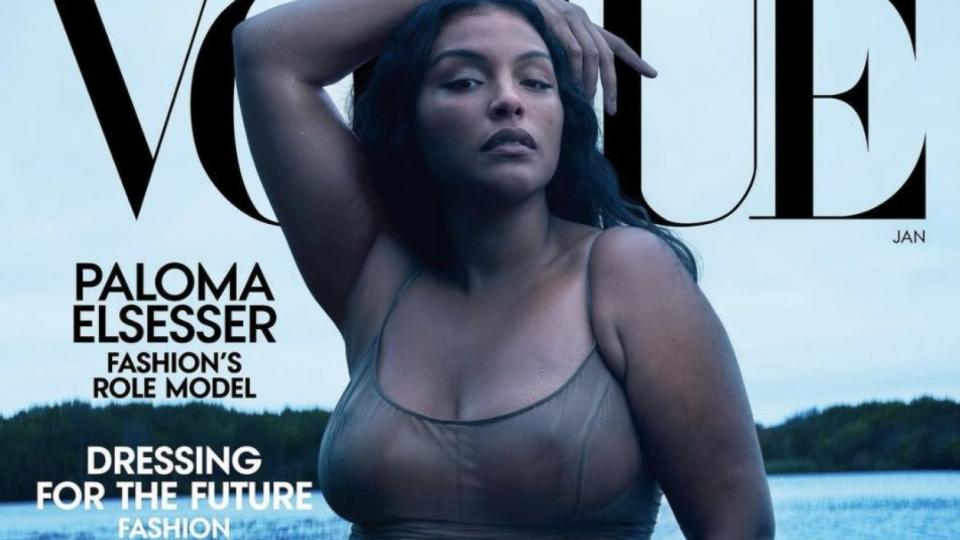‘This is for the girls’: Paloma Elsesser ushers in a new vanguard at Vogue

Jessica Hoppe is In The Know’s culture contributor. Follow her on Instagram and Twitter for more.
“This is for the girls,” Gabriella Karefa-Johnson captioned below an image of Vogue’s January 2021 cover starring model Paloma Elsesser on her Instagram. Johnson, who styled the feature, echoed our collective sentiment at the sight of the first cover story of the new year — one modeled, styled and written by Black women.
While the effort to democratize the fashion industry mostly occurs on the ground, the credit is often attributed to those in the highest echelons, such as the editors of American Vogue, widely considered the most influential fashion magazine in the world.
Editor-in-chief Anna Wintour told Fashionista that choosing a cover person is a matter of cultural relevance — with diversity and representation at the forefront of decision-making. “Inclusivity is critical to this effort. We want to reflect the culture.” However, research capturing data across the top ten U.S. fashion magazines reported a dip in racial diversity on the covers last year — dropping from 48.4 percent (62 of 128 covers) in 2018 to 42.9 percent (70 out of 163 covers). Vogue’s percentage was below the overall average at 33 percent while every single cover story was written by a white writer.
In a major announcement this week, Condé Nast announced six new leadership roles within the editorial division, and only two of these will be held by people of color: Edward Enninful will expand his oversight in the UK across Europe as the head of Vogue’s editions in Britain, France, Italy, Germany and Spain; Radhika Jones will continue to lead the American and British versions of Vanity Fair. Despite rumors of a shake up, Wintour herself was promoted to worldwide chief content officer and global editorial director of Vogue, spanning thirty markets.
With Wintour’s worldwide influence expanding, analysis of 2021’s first issue of the glossy is sure to be keen, and the choice to elevate Paloma Elsesser and the team of Black creatives as the vanguard of that new narrative raises confidence. The 28-year-old, Black, multiracial, size 14 model broke barriers many never conceived possible. “When she started, there was no one else like her — especially among curve models,” IMG’s director Mina White told Vogue. “Paloma had to come in and create her own category.”
Beyond deconstructing the notoriously toxic, white supremacist and fatphobic culture of the fashion industry, Elsesser is taking on a label many celebrities rebuke: role model. “Not every part of fashion needs to focus on politics and reality — this isn’t CNN,” Elsesser told Vogue in a feature written by senior fashion news writer Janelle Okwodu “But ultimately, we all have a level of responsibility. What’s the downside of giving visibility to disabled people, putting dark-skinned femmes at the forefront, or prioritizing diverse perspectives?”
Foregoing the oft-political and assiduous effort many public figures pay to creating an image, Elsesser keeps it real. “When I see the clothes that are offered to our community and see what extended sizing looks like, do I feel validated and seen? No,” she told Vogue. “We have to be incredibly resourceful because we don’t have the luxury of just walking into a store and picking out what we like.”
Though her beauty harkens back to the Golden Age of Hollywood — she’s been compared to Dorothy Dandridge, Lena Horne and Rita Hayworth — it is her authenticity that is most alluring. “Oh my God, I’m so nervous, my heart’s beating out of my chest,” Elsesser told her mother and grandmother via Zoom as she recorded opening the cover for the very first time. “Look, mom!” she cried as gasps and tears of joy resounded in a video that will make history as the most heart-warming moment in fashion.
“[I’m] happy for the little Black girls who can go to the newsstand and buy the world’s most powerful fashion magazine and see themselves on the cover and in the creative team that brought it to life, ” wrote stylist Johnson. “This is the first Vogue cover styled by a Black woman. This is my first Vogue cover. It was shot by Annie Leibovitz and that’s just about the wildest thing I’ve ever heard.”
Wintour defined cultural relevance as those at the forefront of conversation — whether they be in fashion or not — she described as looking for a set of values. “What does this person stand for?” she told Fashionista. “Subjects who have real stories to tell, who are taking chances, or putting themselves on the line in some way are ideal subjects for a cover.” Elsesser and the team of creatives narrating this month’s cover are the perfect answer.
If you enjoyed this story, check out Jessica Hoppe’s personal essay on student loan debt.
More from In The Know:
Treat the budding chef in your life to these top-rated gifts
3 fantastic gifts for your fitness-obsessed friend
7 gadgets to buy if you want to upgrade your home office
Store your leftovers like a pro with these products from Walmart
The post ‘This is for the girls’: Paloma Elsesser ushers in a new vanguard at Vogue appeared first on In The Know.

 Yahoo Finance
Yahoo Finance 